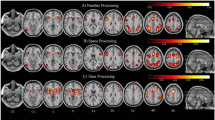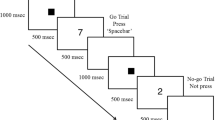Abstract
The direction of influence between conceptual and motor activation, and its relevance for real-life activities, is still unclear. Here, we use the frequently reported association between small/large numbers and left/right space to investigate this issue during walking. We asked healthy adults to generate random numbers as they made lateral turns and found that (1) lateral turn decisions are predicted by the last few numbers generated prior to turning; (2) the intention to turn left/right makes small/large numbers more accessible; and (3) magnitude but not order of auditorily presented numbers influences the listener’s turn selection. Our findings document a bidirectional influence between conceptual and motor activation and point to a hierarchically organized conceptual–motor activation.


Similar content being viewed by others
Notes
Aside from these studies of sensory and motor processes in relation to numerical cognition, there are some studies showing only unilateral spatial biases or spatial biases in the vertical or radial dimensions (e.g., Shaki and Fischer 2012; Gevers et al. 2006), and more recent thoughts about a working memory involvement in SNARC (cf. Van Dijck and Fias 2011). These and other recent studies (e.g., Ferrè et al. 2013; Hartmann et al. 2012; Grade et al. 2013) show that number-space interactions are not necessarily uniform, and that alternative, non-sensory-motoric interpretations of the SNARC effect, such as sequential order in working memory or a polarity correspondence between magnitudes and space, may exist. For a fuller review, please refer to Göbel et al. (2011).
References
Badets A, Pesenti M (2010) Creating number semantics through finger movement perception. Cognition 115:46–53
Badets A, Bouquet CA, Ric F, Pesenti M (2012) Number-generation bias after action observation. Exp Brain Res 221:43–49
Barsalou LW (2008) Grounded cognition. Ann Rev Psychol 59:617–645
Beauchet O, Dubost V, Gonthier R, Kressig RW (2005) Dual-task-related gait changes in transitionally frail older adults: the type of the walking-associated cognitive task matters. Gerontology 51(1):48–52
Beauchet O, Allali G, Annweiler C, Berrut G, Maarouf N, Herrmann FR, Dubost V (2008) Does change in gait while counting backward predict the occurrence of a first fall in older adults? Gerontology 54(4):217–223
Broadbent DE (1991) A word before leaving. In: Meyer DE, Kornblum S (eds) Attention and performance XIV. Bradford Books/MIT Press, Cambridge, pp 863–879
Brozzoli C, Ishihara M, Goebel SM, Salemme R, Rossetti Y, Farne A (2008) Touch perception reveals the dominance of spatial over digital representation of numbers. Proc Natl Acad Sci USA 105(14):5644–5648
Brugger P, Macas E, Ihlemann J (2002) Do sperm cells remember? Behav Brain Res 136:325–328
Bueti D, Walsh V (2009) The parietal cortex and the representation of time, space, number and other magnitudes. Philos Trans R Soc Lond B Biol Sci 364:1831–1840
Daar M, Pratt J (2008) Digits affect actions: the SNARC effect and response selection. Cortex 44:400–405
Dehaene S (1997) The number sense. Basic Books, New York
Dehaene S, Bossini S, Giraux P (1993) The mental representation of parity and number magnitude. J Exp Psychol Gen 122:371–396
Eerland A, Guadalupe TM, Zwaan RA (2011) Leaning to the left makes the Eiffel Tower seem smaller: posture-modulated estimation. Psychol Sci 22(12):1511–1514
Ferrè ER, Vagnoni E, Haggard P (2013) Galvanic vestibular stimulation influences randomness of number generation. Exp Brain Res 224(2):233–241
Fischer MH (2003) Spatial representations in number processing—evidence from a pointing task. Vis Cogn 10:493–508
Fischer MH (2012) A hierarchical view of grounded, embodied and situated numerical cognition. Cogn Process 13:S161–S164
Fischer MH, Brugger P (2011) When digits help digits: spatial-numerical associations point to finger counting as prime example of embodied cognition. Front in Psychol 2:1–7
Fischer MH, Dahl C (2007) The time course of visuo-motor affordances. Exp Brain Res 176(3):519–524
Fischer MH, Zwaan RA (2008) Embodied language: a review of the role of the motor system in language comprehension. Q J Exp Psychol 61(6):825–850
Fischer MH, Castel AD, Dodd MD, Pratt J (2003) Perceiving numbers causes spatial shifts of attention. Nat Neurosci 6(6):555–556
Fischer MH, Warlop N, Hill RL, Fias W (2004) Oculomotor bias induced by number perception. Exp Psychol 51(2):91–97
Gevers W, Lammertyn J, Notebaert W, Verguts T, Fias W (2006) Automatic response activation of implicit spatial information: evidence from the SNARC effect. Acta Psychol 122(3):221–233
Göbel SM, Shaki S, Fischer MH (2011) The cultural number line: a review of cultural and linguistic influences on the development of number processing. J Cross Cult Psychol 42:543–565
Grade S, Lefèvre N, Pesenti M (2013) Influence of gaze observation on random number generation. Exp Psychol 60(2):122–130
Hartmann M, Grabherr L, Mast FW (2012) Moving along the number line: interactions between whole-body motion and numerical cognition. J Exp Psychol Hum Percept Perform 38:1416–1427
Imbo I, Vandierendonck A, Fias W (2011) Passive hand movements disrupt adults’ counting strategies. Front Psychol. doi:10.3389/fpsyg.2011.00201
Kingstone A, Smilek D, Eastwood JD (2008) Cognitive ethology: a new approach for studying human cognition. Br J Psychol 99:317–340
Loetscher T, Brugger P (2007) Exploring number space by random digit generation. Exp Brain Res 180(4):655–665
Loetscher T, Schwarz U, Schubiger M, Brugger P (2008) Head turns bias the brain’s internal random generator. Curr Biol 18:60–62
Loetscher T, Bockisch C, Nicholls M, Brugger P (2010) Eye position predicts what number you have in mind. Curr Biol 20:R264–R265
Michaux N, Masson N, Pesenti M, Andres M (2012) Selective finger interference with basic arithmetic problem solving. Exp Psychol 21:1–9
Mohr C, Brugger P, Bracha HS, Landis T, Viaud-Delmon I (2004) Human side preferences in three different whole-body movement tasks. Behav Brain Res 151:321–326
Plaisier MA, Smeets JBJ (2011) Number to finger mapping is topological. Exp Brain Res 209:395–400
Pöppel E (1997) A hierarchical model of temporal perception. Trends Cogn Sci 1:56–61
Pulvermüller F (2005) Brain mechanisms linking language and action. Nat Rev Neurosci 6(7):576–582
Ranzini M, Lugli L, Anelli F, Carbone R, Nicoletti R, Borghi AM (2011) Graspable objects shape number processing. Front Hum Neurosci 5:147. doi:10.3389/fnhum.2011.00147
Rosenbaum DA (1980) Human movement initiation: specification of arm, direction, and extent. J Exp Psychol Gen 109:444–474
Rosenbaum DA (2010) Human motor control, 2nd edn. University Press, Oxford
Rosenthal R, Rosnow RL (1984) Essentials of behavioral research. McGraw Hill, New York
Shaki S, Fischer MH (2012) Multiple spatial mappings in numerical cognition. J Exp Psychol Human 38(3):804–809
Souman JL, Frissen I, Sreenivasa MN, Ernst MO (2009) Walking straight into circles. Curr Biol 19:1538–1542
Tschentscher N, Fischer MH (2008) Grasp cueing and joint attention. Exp Brain Res 190(4):493–498
Van Dijck JP, Fias W (2011) A working memory account for spatial-numerical associations. Cognition 119(1):114–119
Vicario CM (2012) Perceiving numbers affects the internal random movement generator. Sci World J. doi:10.1100/2012/347068
Walsh V (2003) A theory of magnitude: common cortical metrics of time, space and quantity. Trends Cogn Sci 7(11):483–488
Williams LE, Bargh JA (2008) Experiencing physical warmth promotes interpersonal warmth. Science 322:606–607
Wood G, Nuerk HC, Willmes K, Fischer MH (2008) On the cognitive link between space and number: a meta-analysis of the SNARC effect. Psychol Sci Q 50(4):489–525
Acknowledgments
We thank Anna Vaisertraiger for her help with data collection and several anonymous reviewers for comments that helped to improve this report.
Author information
Authors and Affiliations
Corresponding author
Rights and permissions
About this article
Cite this article
Shaki, S., Fischer, M.H. Random walks on the mental number line. Exp Brain Res 232, 43–49 (2014). https://doi.org/10.1007/s00221-013-3718-7
Received:
Accepted:
Published:
Issue Date:
DOI: https://doi.org/10.1007/s00221-013-3718-7




